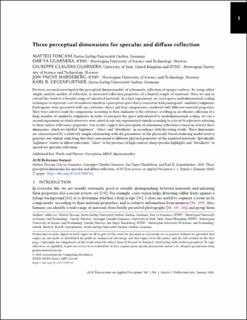| dc.contributor.author | Toscani, Matteo | |
| dc.contributor.author | Guarnera, Dar'ya | |
| dc.contributor.author | Guarnera, Giuseppe Claudio | |
| dc.contributor.author | Hardeberg, Jon Yngve | |
| dc.contributor.author | Gegenfurtner, Karl | |
| dc.date.accessioned | 2021-05-31T11:25:01Z | |
| dc.date.available | 2021-05-31T11:25:01Z | |
| dc.date.created | 2020-09-01T16:40:58Z | |
| dc.date.issued | 2020 | |
| dc.identifier.citation | ACM Transactions on Applied Perception. 2020, 17 (2), . | en_US |
| dc.identifier.issn | 1544-3558 | |
| dc.identifier.uri | https://hdl.handle.net/11250/2757055 | |
| dc.description.abstract | Previous research investigated the perceptual dimensionality of achromatic reflection of opaque surfaces, by using either simple analytic models of reflection or measured reflection properties of a limited sample of materials. Here, we aim to extend this work to a broader range of simulated materials. In a first experiment, we used sparse multidimensional scaling techniques to represent a set of rendered stimuli in a perceptual space that is consistent with participants’ similarity judgments. Participants were presented with one reference object and four comparisons, rendered with different material properties. They were asked to rank the comparisons according to their similarity to the reference, resulting in an efficient collection of a large number of similarity judgments. To interpret the space individuated by multidimensional scaling, we ran a second experiment in which observers were asked to rate our experimental stimuli according to a list of 30 adjectives referring to their surface reflectance properties. Our results suggest that perception of achromatic reflection is based on at least three dimensions, which we labelled “Lightness,” “Gloss,” and “Metallicity,” in accordance with the rating results. These dimensions are characterized by a relatively simple relationship with the parameters of the physically based rendering model used to generate our stimuli, indicating that they correspond to different physical properties of the rendered materials. Specifically, “Lightness” relates to diffuse reflections, “Gloss” to the presence of high contrast sharp specular highlights, and “Metallicity” to spread out specular reflections. | en_US |
| dc.language.iso | eng | en_US |
| dc.publisher | ACM | en_US |
| dc.title | Three perceptual dimensions for specular and diffuse reflection | en_US |
| dc.type | Peer reviewed | en_US |
| dc.type | Journal article | en_US |
| dc.description.version | acceptedVersion | en_US |
| dc.source.pagenumber | 26 | en_US |
| dc.source.volume | 17 | en_US |
| dc.source.journal | ACM Transactions on Applied Perception | en_US |
| dc.source.issue | 2 | en_US |
| dc.identifier.doi | 10.1145/3380741 | |
| dc.identifier.cristin | 1826573 | |
| dc.relation.project | Norges forskningsråd: 250293 | en_US |
| dc.relation.project | Norges forskningsråd: 288670 | en_US |
| dc.description.localcode | © ACM, 2020. This is the author's version of the work. It is posted here by permission of ACM for your personal use. Not for redistribution. The definitive version was published here, DOI 10.1145/3380741 | en_US |
| cristin.ispublished | true | |
| cristin.fulltext | postprint | |
| cristin.qualitycode | 1 | |
